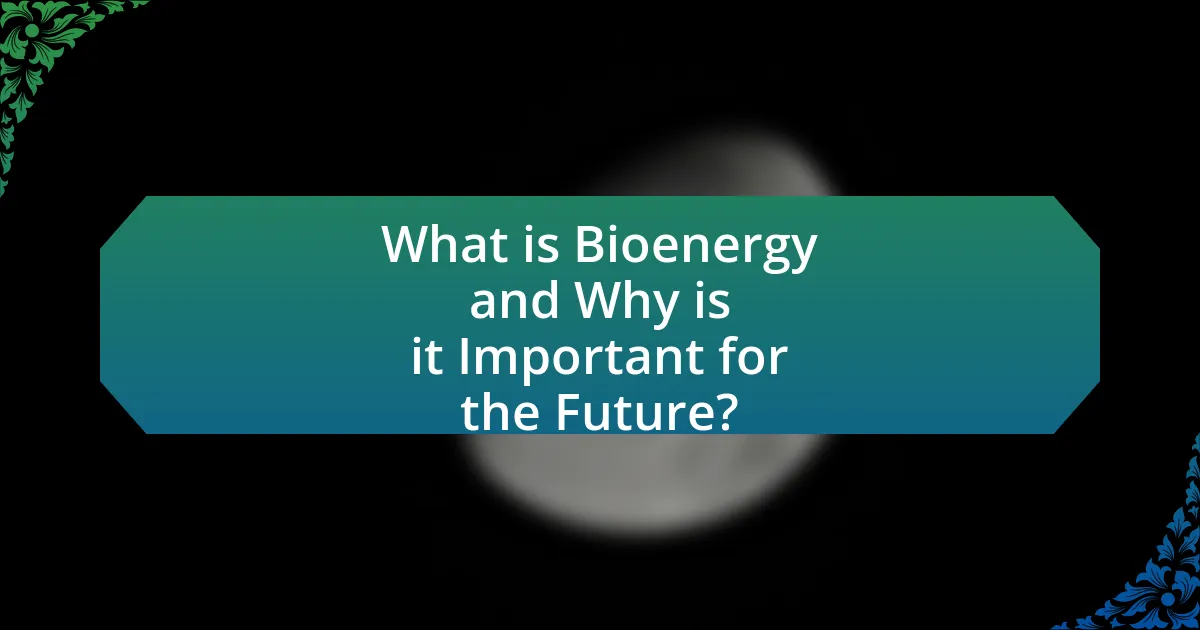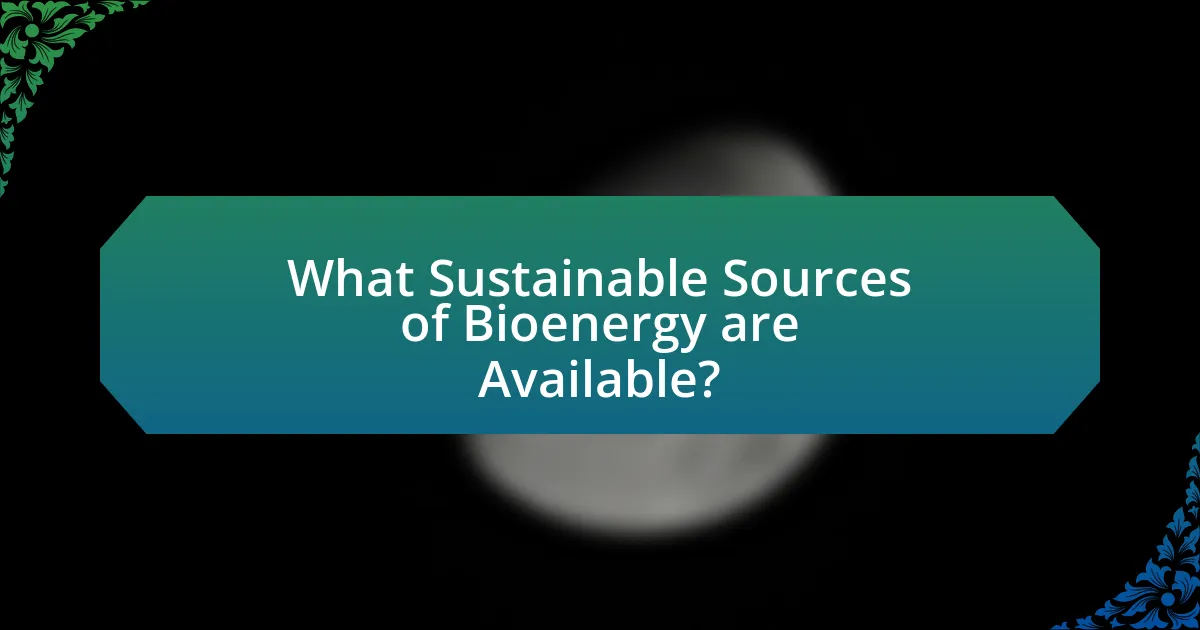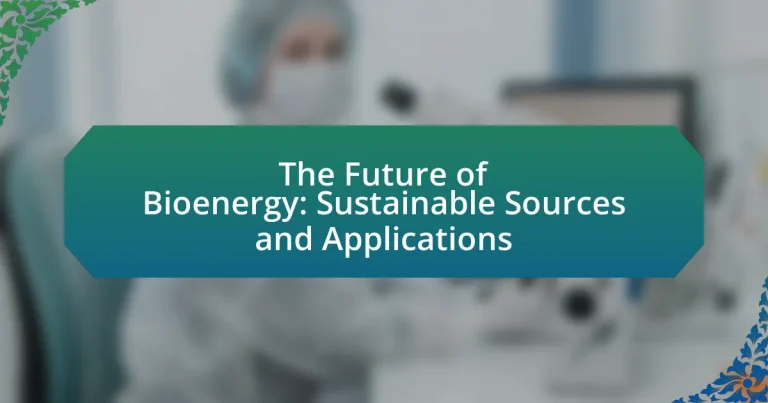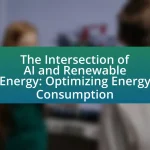Bioenergy, derived from organic materials such as plants and animal waste, is a renewable energy source that plays a crucial role in reducing greenhouse gas emissions and combating climate change. The article explores the importance of bioenergy for the future, highlighting its potential to meet up to 30% of global energy needs by 2050, enhance energy security, and create economic opportunities. It defines bioenergy in the context of sustainability, discusses its key characteristics, compares it to other renewable sources, and examines its applications across various sectors, including electricity generation, transportation, and heating. Additionally, the article addresses the potential risks associated with bioenergy production, current trends, technological advancements, and best practices for implementing sustainable bioenergy solutions.

What is Bioenergy and Why is it Important for the Future?
Bioenergy is energy derived from organic materials, such as plants and animal waste, which can be converted into fuels, electricity, or heat. It is important for the future because it offers a renewable alternative to fossil fuels, helping to reduce greenhouse gas emissions and combat climate change. According to the International Energy Agency, bioenergy could provide up to 30% of the world’s energy needs by 2050, making it a crucial component of a sustainable energy strategy. Additionally, bioenergy can enhance energy security and create economic opportunities in rural areas through job creation in biomass production and processing.
How is Bioenergy Defined in the Context of Sustainability?
Bioenergy is defined in the context of sustainability as energy derived from organic materials that can be replenished naturally, such as plant biomass, agricultural residues, and animal waste. This definition emphasizes the renewable nature of bioenergy, which contributes to reducing greenhouse gas emissions and reliance on fossil fuels. According to the Intergovernmental Panel on Climate Change (IPCC), sustainable bioenergy can play a significant role in mitigating climate change by providing a low-carbon alternative to traditional energy sources.
What are the key characteristics that make bioenergy sustainable?
The key characteristics that make bioenergy sustainable include renewable resource availability, low greenhouse gas emissions, and efficient land use. Renewable resources, such as agricultural residues and dedicated energy crops, ensure a continuous supply of biomass without depleting natural resources. Low greenhouse gas emissions are achieved when bioenergy production and use result in a net reduction of carbon dioxide compared to fossil fuels, as demonstrated by studies showing that biofuels can reduce emissions by up to 80% compared to conventional gasoline. Efficient land use involves optimizing biomass production on marginal lands, which minimizes competition with food crops and preserves biodiversity. These characteristics collectively contribute to the sustainability of bioenergy as a viable alternative to fossil fuels.
How does bioenergy compare to other renewable energy sources?
Bioenergy is distinct from other renewable energy sources due to its reliance on organic materials for energy production, which can include agricultural residues, wood, and waste. Unlike solar and wind energy, which harness natural phenomena, bioenergy can provide a continuous and controllable energy supply, making it more reliable for baseload power generation. According to the International Energy Agency, bioenergy accounted for approximately 10% of global energy consumption in 2020, highlighting its significant role in the renewable energy landscape. Additionally, bioenergy can contribute to waste management and carbon reduction by utilizing materials that would otherwise decompose and release greenhouse gases.
What Role Does Bioenergy Play in Addressing Climate Change?
Bioenergy plays a crucial role in addressing climate change by providing renewable energy sources that can reduce greenhouse gas emissions. Specifically, bioenergy can replace fossil fuels in electricity generation, heating, and transportation, leading to a significant decrease in carbon dioxide emissions. For instance, the International Energy Agency reported that bioenergy accounted for approximately 10% of global energy supply in 2020, contributing to a reduction of around 1.5 billion tons of CO2 emissions annually. Additionally, bioenergy systems can utilize waste materials, thereby promoting circular economy principles and further mitigating climate impacts.
How can bioenergy contribute to reducing greenhouse gas emissions?
Bioenergy can significantly reduce greenhouse gas emissions by providing a renewable alternative to fossil fuels. When bioenergy is produced from organic materials, such as agricultural residues or dedicated energy crops, it can lead to lower net carbon dioxide emissions compared to traditional energy sources. This is because the carbon dioxide released during the combustion of bioenergy is offset by the carbon dioxide absorbed by the plants during their growth cycle. According to the Intergovernmental Panel on Climate Change (IPCC), sustainable bioenergy can contribute to a reduction of greenhouse gas emissions by up to 70% when compared to fossil fuels, particularly when waste materials are utilized, which also helps in waste management.
What are the potential risks associated with bioenergy production?
The potential risks associated with bioenergy production include land use change, greenhouse gas emissions, and impacts on food security. Land use change can lead to deforestation and habitat loss, which negatively affects biodiversity. A study published in “Nature” by Searchinger et al. (2008) indicates that converting forests or grasslands to bioenergy crops can result in significant carbon emissions, counteracting the climate benefits of biofuels. Additionally, the competition for agricultural land between bioenergy crops and food production can drive up food prices and threaten food security, as highlighted by the Food and Agriculture Organization (FAO) in their reports on bioenergy and food systems.
What are the Current Trends in Bioenergy Development?
Current trends in bioenergy development include the increased use of advanced biofuels, the integration of bioenergy with carbon capture and storage (CCS), and the focus on sustainable feedstock sourcing. Advanced biofuels, such as cellulosic ethanol and algae-based fuels, are gaining traction due to their lower greenhouse gas emissions compared to traditional fossil fuels. The integration of bioenergy with CCS technologies aims to reduce carbon emissions from bioenergy production, making it a more climate-friendly option. Additionally, there is a growing emphasis on sourcing feedstocks sustainably, ensuring that bioenergy production does not compete with food supply or lead to deforestation. According to the International Energy Agency, bioenergy accounted for about 10% of global energy supply in 2021, highlighting its significant role in the energy transition.
How are technological advancements shaping the future of bioenergy?
Technological advancements are significantly shaping the future of bioenergy by enhancing efficiency, reducing costs, and improving sustainability. Innovations such as advanced fermentation techniques and genetic engineering of microorganisms enable the production of biofuels from a wider range of feedstocks, including agricultural waste and non-food crops. For instance, research from the National Renewable Energy Laboratory indicates that these technologies can increase biofuel yields by up to 50%, making bioenergy more competitive with fossil fuels. Additionally, developments in biogas production and carbon capture technologies are facilitating the integration of bioenergy into existing energy systems, further promoting its viability as a sustainable energy source.
What are the emerging markets for bioenergy globally?
Emerging markets for bioenergy globally include Brazil, India, and Southeast Asian countries. Brazil leads in bioethanol production, utilizing sugarcane, while India is expanding its bioenergy sector through agricultural residues and biogas projects. Southeast Asian nations, such as Indonesia and Malaysia, are focusing on palm oil and biomass for energy generation. According to the International Renewable Energy Agency (IRENA), these regions are expected to see significant growth in bioenergy investments, driven by increasing energy demands and government policies promoting renewable energy sources.

What Sustainable Sources of Bioenergy are Available?
Sustainable sources of bioenergy include biomass, biofuels, biogas, and algae. Biomass, derived from organic materials such as agricultural residues, wood, and dedicated energy crops, can be converted into heat, electricity, or fuels. Biofuels, such as ethanol and biodiesel, are produced from crops like corn and sugarcane, as well as from waste oils. Biogas, generated through anaerobic digestion of organic matter, can be used for heating or electricity generation. Algae, which can be cultivated in various environments, are a promising source for biofuels due to their high oil content and rapid growth rates. These sources contribute to reducing greenhouse gas emissions and promoting energy security.
What are the Different Types of Biomass Used for Bioenergy?
The different types of biomass used for bioenergy include wood, agricultural residues, animal manure, and dedicated energy crops. Wood biomass, such as logs, chips, and sawdust, is commonly utilized due to its high energy content and availability. Agricultural residues, including straw and corn stover, are by-products of crop production that can be converted into bioenergy, contributing to waste reduction. Animal manure serves as a biomass source through anaerobic digestion, producing biogas for energy. Dedicated energy crops, like switchgrass and miscanthus, are specifically cultivated for bioenergy production, offering high yields and efficient conversion to energy. These biomass types collectively support the transition to renewable energy sources, as evidenced by the growing bioenergy sector, which accounted for approximately 5% of total U.S. energy consumption in 2020, according to the U.S. Energy Information Administration.
How do agricultural residues contribute to bioenergy production?
Agricultural residues contribute to bioenergy production by serving as a renewable feedstock for various bioenergy processes, including bioethanol and biogas production. These residues, such as crop leftovers, straw, and husks, can be converted into energy through methods like anaerobic digestion and fermentation. For instance, the Food and Agriculture Organization (FAO) estimates that agricultural residues could provide approximately 30% of the global bioenergy supply, highlighting their significant potential in reducing reliance on fossil fuels and promoting sustainable energy practices.
What role do dedicated energy crops play in sustainable bioenergy?
Dedicated energy crops are essential for sustainable bioenergy as they provide a renewable source of biomass specifically cultivated for energy production. These crops, such as switchgrass and miscanthus, are designed to optimize yield and minimize environmental impact, contributing to reduced greenhouse gas emissions and enhanced soil health. Research indicates that dedicated energy crops can produce significantly higher biomass per acre compared to traditional food crops, with studies showing yields of up to 10 tons per acre annually. This efficiency supports the transition to a low-carbon energy system while ensuring food security by not competing with food crops for land.
How is Waste Utilized as a Source of Bioenergy?
Waste is utilized as a source of bioenergy through processes such as anaerobic digestion and biomass combustion. Anaerobic digestion involves microorganisms breaking down organic waste in the absence of oxygen, producing biogas, which primarily consists of methane and can be used for electricity generation or as a vehicle fuel. Biomass combustion involves burning organic materials, such as agricultural residues or wood, to produce heat and electricity. According to the U.S. Energy Information Administration, biomass accounted for about 5% of total U.S. energy consumption in 2020, demonstrating its significant role in the energy mix.
What types of waste are most effective for bioenergy conversion?
Organic waste, particularly agricultural residues, food waste, and animal manure, are the most effective types of waste for bioenergy conversion. Agricultural residues, such as straw and corn stover, contain high cellulose content, making them suitable for anaerobic digestion and fermentation processes that produce biogas and bioethanol. Food waste, which constitutes about one-third of global food production, can be efficiently converted into biogas through anaerobic digestion, yielding significant energy outputs. Animal manure, rich in organic matter and nutrients, is also a prime candidate for bioenergy production, as it can be processed to generate biogas while simultaneously reducing environmental pollution. These waste types not only provide a renewable energy source but also contribute to waste management and reduction of greenhouse gas emissions.
How does waste-to-energy technology work?
Waste-to-energy technology converts municipal solid waste into usable energy, primarily through processes like combustion, gasification, and anaerobic digestion. In combustion, waste is burned at high temperatures, producing steam that drives turbines to generate electricity. Gasification involves heating waste in a low-oxygen environment to produce syngas, which can be used for electricity or fuel production. Anaerobic digestion breaks down organic waste in the absence of oxygen, producing biogas that can be used for heating or electricity. According to the U.S. Environmental Protection Agency, waste-to-energy facilities can reduce the volume of waste by up to 90%, while generating renewable energy, thus contributing to sustainable waste management and energy production.
What Innovations are Emerging in Bioenergy Sources?
Innovations emerging in bioenergy sources include advanced biofuels, biogas production from organic waste, and algae-based energy solutions. Advanced biofuels, such as cellulosic ethanol and biodiesel from non-food feedstocks, are being developed to reduce competition with food crops and lower greenhouse gas emissions. Biogas production utilizes anaerobic digestion of organic waste, converting it into methane for energy, which enhances waste management and energy recovery. Algae-based energy solutions leverage the rapid growth of algae to produce biofuels and bioproducts, offering a sustainable alternative due to their high yield and ability to absorb CO2. These innovations are supported by research indicating that advanced biofuels can reduce lifecycle greenhouse gas emissions by up to 80% compared to fossil fuels, as reported by the U.S. Department of Energy.
How are algae being explored as a sustainable bioenergy source?
Algae are being explored as a sustainable bioenergy source due to their high biomass yield and ability to produce lipids that can be converted into biodiesel. Research indicates that certain algae species can produce up to 30 times more oil per acre than traditional crops like soybeans. Additionally, algae can utilize carbon dioxide from industrial emissions, thus contributing to carbon capture efforts. Studies, such as those published in “Renewable and Sustainable Energy Reviews” by authors including Chisti, highlight the potential of algae to produce not only biodiesel but also bioethanol and biogas, making them versatile in bioenergy applications.
What advancements are being made in cellulosic biofuels?
Recent advancements in cellulosic biofuels include the development of more efficient enzymatic processes and improved microbial strains for biomass conversion. Research has shown that using engineered enzymes can significantly enhance the breakdown of lignocellulosic materials, increasing the yield of fermentable sugars. For instance, a study published in the journal “Nature Biotechnology” by Zhang et al. (2021) demonstrated that genetically modified microorganisms can convert cellulose to ethanol with over 90% efficiency, compared to traditional methods that often yield less than 50%. Additionally, advancements in pretreatment technologies, such as steam explosion and ionic liquid treatments, have improved the accessibility of cellulose in plant materials, further boosting biofuel production efficiency.

What are the Applications of Bioenergy in Various Sectors?
Bioenergy has diverse applications across various sectors, including electricity generation, transportation, heating, and agriculture. In electricity generation, bioenergy contributes to renewable energy sources, with biomass power plants converting organic materials into electricity, accounting for approximately 2.5% of total U.S. electricity generation in 2020. In transportation, biofuels such as ethanol and biodiesel derived from biomass are used to power vehicles, reducing greenhouse gas emissions; for instance, in 2021, biofuels contributed to about 5% of the total transportation fuel used in the U.S. Heating applications utilize bioenergy in residential and industrial settings, where biomass can replace fossil fuels for heating purposes. In agriculture, bioenergy supports sustainable practices through the use of agricultural waste for energy production, enhancing resource efficiency and reducing waste. These applications demonstrate bioenergy’s role in promoting sustainability and reducing reliance on fossil fuels across multiple sectors.
How is Bioenergy Used in Transportation?
Bioenergy is used in transportation primarily as biofuels, which include ethanol and biodiesel. Ethanol, derived from crops like corn and sugarcane, is blended with gasoline to reduce greenhouse gas emissions and enhance fuel performance. Biodiesel, produced from vegetable oils or animal fats, can be used in diesel engines, providing a renewable alternative to petroleum-based diesel. According to the U.S. Energy Information Administration, in 2021, biofuels accounted for about 5% of total U.S. transportation fuel consumption, demonstrating their growing role in reducing reliance on fossil fuels and promoting sustainability in the transportation sector.
What types of biofuels are commonly used in vehicles?
Commonly used biofuels in vehicles include biodiesel and ethanol. Biodiesel, derived from vegetable oils or animal fats, can be used in diesel engines and is known for reducing greenhouse gas emissions by up to 86% compared to fossil fuels. Ethanol, primarily produced from corn or sugarcane, is often blended with gasoline and can reduce carbon emissions by approximately 30% when used in flexible fuel vehicles. These biofuels are recognized for their potential to enhance energy security and promote sustainable transportation.
How does bioenergy impact the aviation industry?
Bioenergy significantly impacts the aviation industry by providing a sustainable alternative to conventional fossil fuels. The use of biofuels, derived from organic materials, can reduce greenhouse gas emissions by up to 80% compared to traditional jet fuels, according to a study by the International Air Transport Association (IATA). This transition to bioenergy not only helps airlines meet regulatory requirements for emissions reductions but also enhances energy security by diversifying fuel sources. Furthermore, biofuels can be blended with existing jet fuels, allowing for a seamless integration into current aviation infrastructure without requiring major modifications to aircraft engines.
What Role Does Bioenergy Play in Electricity Generation?
Bioenergy plays a significant role in electricity generation by converting organic materials into renewable energy sources. This process includes the combustion of biomass, such as wood, agricultural residues, and waste, to produce heat, which is then used to generate electricity through steam turbines. According to the U.S. Energy Information Administration, bioenergy accounted for approximately 1.5% of total U.S. electricity generation in 2021, highlighting its contribution to the energy mix. Additionally, bioenergy can be utilized in biogas production, where anaerobic digestion of organic matter produces methane that can be burned for electricity generation. This dual capability of bioenergy not only supports energy production but also aids in waste management and reduces greenhouse gas emissions, reinforcing its importance in sustainable energy strategies.
How do biomass power plants operate?
Biomass power plants operate by converting organic materials, such as wood, agricultural residues, and waste, into electricity and heat through combustion or biochemical processes. In the combustion method, biomass is burned in a boiler to produce steam, which drives a turbine connected to a generator, thereby generating electricity. Alternatively, biochemical processes like anaerobic digestion break down organic matter to produce biogas, which can also be used to generate electricity. According to the U.S. Energy Information Administration, biomass energy accounted for about 5% of total U.S. electricity generation in 2020, demonstrating its role as a renewable energy source.
What are the benefits of integrating bioenergy into the grid?
Integrating bioenergy into the grid enhances energy security and reduces greenhouse gas emissions. Bioenergy provides a renewable source of electricity that can be generated from organic materials, such as agricultural waste and dedicated energy crops, which helps diversify the energy mix. According to the U.S. Department of Energy, bioenergy can contribute to a reduction of carbon dioxide emissions by up to 80% compared to fossil fuels when sustainably sourced. Additionally, bioenergy systems can offer grid stability through flexible generation, as they can quickly ramp up or down to meet demand fluctuations, thus supporting the integration of intermittent renewable sources like wind and solar.
How is Bioenergy Applied in Heating and Cooling Systems?
Bioenergy is applied in heating and cooling systems primarily through biomass heating systems and biogas utilization. Biomass heating systems convert organic materials, such as wood pellets or agricultural residues, into heat energy for residential and industrial applications. For instance, according to the U.S. Energy Information Administration, biomass accounted for about 4% of total U.S. energy consumption in 2020, demonstrating its role in providing renewable heat.
Biogas, produced from the anaerobic digestion of organic waste, can be used in combined heat and power (CHP) systems, generating both electricity and heat. The International Renewable Energy Agency reports that biogas can significantly reduce greenhouse gas emissions compared to fossil fuels, making it a sustainable option for heating.
These applications highlight bioenergy’s effectiveness in enhancing energy efficiency and reducing reliance on non-renewable energy sources in heating and cooling systems.
What technologies are used for bioenergy heating solutions?
Bioenergy heating solutions utilize technologies such as biomass boilers, anaerobic digesters, and combined heat and power (CHP) systems. Biomass boilers convert organic materials like wood pellets and agricultural residues into heat through combustion, providing a renewable energy source. Anaerobic digesters break down organic waste to produce biogas, which can be used for heating or electricity generation. CHP systems simultaneously generate heat and electricity from biofuels, enhancing energy efficiency. These technologies contribute to reducing greenhouse gas emissions and promoting sustainable energy practices.
How does bioenergy contribute to energy efficiency in buildings?
Bioenergy enhances energy efficiency in buildings by providing renewable energy sources that can replace fossil fuels for heating, electricity, and hot water. Utilizing biomass, such as wood pellets or agricultural residues, bioenergy systems can significantly reduce greenhouse gas emissions and lower energy costs. For instance, a study by the U.S. Department of Energy found that biomass heating systems can achieve efficiencies of over 80%, compared to traditional heating systems that often operate below 70% efficiency. This transition not only optimizes energy use but also promotes sustainability by utilizing locally sourced materials, thereby reducing transportation energy and emissions.
What are the Best Practices for Implementing Bioenergy Solutions?
The best practices for implementing bioenergy solutions include conducting thorough feasibility studies, ensuring sustainable feedstock sourcing, and integrating advanced technologies for conversion processes. Feasibility studies assess the economic, environmental, and social impacts of bioenergy projects, which is crucial for informed decision-making. Sustainable feedstock sourcing minimizes competition with food production and protects biodiversity, as highlighted by the Food and Agriculture Organization, which emphasizes the importance of using waste materials and non-food crops. Advanced technologies, such as anaerobic digestion and gasification, enhance efficiency and reduce emissions, aligning with the goals of the International Renewable Energy Agency, which reports that these technologies can significantly improve the overall sustainability of bioenergy systems.
How can organizations effectively transition to bioenergy sources?
Organizations can effectively transition to bioenergy sources by conducting a comprehensive assessment of their current energy usage and identifying suitable bioenergy alternatives. This involves evaluating local biomass resources, such as agricultural residues or waste materials, which can be converted into energy. For instance, the U.S. Department of Energy reports that bioenergy can provide up to 5% of the total U.S. energy supply, highlighting its potential.
Additionally, organizations should invest in technology for bioenergy production, such as anaerobic digesters or biomass boilers, to facilitate the conversion process. Collaborating with local governments and stakeholders can also enhance access to funding and resources, as seen in successful case studies like the European Union’s Bioenergy Strategy, which promotes sustainable practices across member states.
Training employees on bioenergy systems and integrating bioenergy into existing energy management plans will further support this transition. By following these steps, organizations can not only reduce their carbon footprint but also contribute to a more sustainable energy future.
What considerations should be made for sustainable bioenergy projects?
Sustainable bioenergy projects should prioritize environmental impact, resource efficiency, and social equity. Environmental impact considerations include assessing land use changes, greenhouse gas emissions, and biodiversity effects associated with biomass production. Resource efficiency involves optimizing feedstock selection, energy conversion processes, and waste management to minimize resource consumption and maximize energy output. Social equity requires engaging local communities, ensuring fair access to benefits, and addressing potential displacement or livelihood impacts. Research indicates that projects integrating these considerations can enhance sustainability, as evidenced by studies showing that well-managed bioenergy systems can reduce carbon footprints and support local economies.




